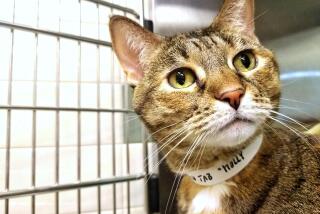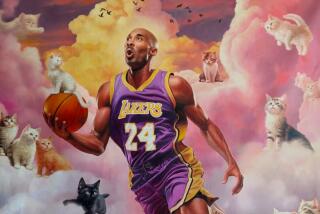‘Simon’s Cat’ creator Simon Tofield on his wildly popular kitty
If there’s one thing people can’t seem to get enough of on YouTube, it’s cat videos, real and animated. “Simon’s Cat,” from British animator Simon Tofield, has logged 280 million views since launching in 2008 -- and, by the time you’ve finished reading this, quite a few more.
Tofield is coming to the L.A. Times Festival of Books -- not for the videos, but for the “Simon’s Cat” book series; the third volume, “Simon’s Cat in Kitten Chaos,” is out April 16. The book includes a sheet of stickers, as well as a section teaching readers how to draw their favorite “Simon’s Cat” characters. In it, Simon’s cat meets his match: a new kitten found in a cardboard box. But does that really matter? It’s Simon’s cat, wordlessly doing more bug-eyed cat things.
Tofield will be at Family Bookstore on April 19 at 7:30 p.m. and at the L.A. Times Festival of Books on Saturday, April 20, at the 3:30 p.m. panel, “Feathers and Fur: Cute Animal Tales.” We caught up with the award-winning animator and illustrator over email to ask about his dynamic with his own cats, and why most of us can’t get through the day without watching a video of a cat staring at its own reflection in the mirror (just me?).
The “Simon’s Cat” books are based on your popular YouTube cartoon. What inspired you to create the Simon’s Cat cartoon series?
One of my four cats is called Hugh. Back when he was a kitten he had a habit of waking me up every day by purring in my face and nibbling on my earlobes. At around this time I was also trying to teach myself how to use some animation software called Adobe Flash. It occurred to me that Hugh would make the perfect subject for my experiments in Flash, so he became the star and inspiration of my first Simon’s Cat video called “Cat Man Do.”
As I mentioned I also have three other cats. So in total I have Hugh, Jess, Maisy and Teddy. Since the first film, “Cat Man Do,” all of my cats have played their part in inspiring films and pages in my books.
What, if any, challenges did you meet when you decided to change mediums for “Simon’s Cat” — moving from animated videos to illustrations in a book?
That’s a good question. When I animate a film, I will literally draw hundreds if not thousands of drawings in order to tell the story. But often a story or gag in one of my books might be summed up in a single drawing.
While both animation and illustration require drawing skills, good animation also needs a feel for timing and in the case of Simon’s Cat especially comic timing to best bring out the humor. In my books the aim is more to succinctly define a moment or story with as few drawings as possible.
From when I was a young boy I’ve always drawn on paper. So for me, taking Simon’s Cat to book form was a very natural path to take.
What is it about cats that made them such a comedic and appealing subject for your cartoons?
Cats are loved worldwide. And cats in England are very similar in behavior to those in America, Japan, France, Germany and really the whole world over. They are almost the perfect universal subject for animation! Much of the success of Simon’s Cat is owed to the fact they are extremely popular animals.
Your drawings are in simple black and white, and you use no words or dialogue in the cartoons. Why did you decide not to use words in “Simon’s Cat”? And how do you go about successfully telling a detailed, comedic story using only images?
If you are a cat owner you’ll know they are all about body language. This is how they communicate with each other and also with humans.
The reason Simon’s Cat doesn’t speak is because he is a real cat. And real cats don’t speak or even need to speak. They are very expressive animals which use their entire bodies to indicate how they feel.
Luckily, living with four cats I have a constant reminder of how they behave, with them providing funny moments almost every day. I just have to watch the masters at play.
You have a fan base of children and adults all over the world. What do you think it is about “Simon’s Cat” that appeals to such a wide demographic?
Most of the time I try to keep Simon’s Cat recognizable as a real cat. This is his foundation. As long as he displays true cat behavior in some way, I think people recognize something in him and think “He’s just like my cat” or “I’ve seen a cat do that.” That as the starting point, along with the general popularity of cats, is what I think has made Simon’s Cat so appealing.
“Simon’s Cat in Kitten Chaos” is the third installment in your book series. How do you continue to keep the content and the stories fresh and imaginative?
The secret is just living with cats!
Growing up, what were some of the cartoons that inspired you? What are some of your favorites today?
What got me first interested in animation was the Transformers cartoons from the 1980s. I used to play them on VHS tape and with the aid of the pause button, I’d analyze how specific actions were drawn. And I’d put these to paper in little flip books I used to make to test the animation.
As I got older I discovered “The Far Side” by Gary Larson as well as “Calvin and Hobbes” by Bill Watterson. Their work is inspirational as well as hugely enjoyable.
What projects are on the horizon for the “Simon’s Cat” installment?
The universe of Simon’s Cat expands with every book. And now there is a relatively large cast waiting in the wings. I can already tell the kitten is a hugely popular character so I am sure we’ll be seeing a lot more of him.
ALSO:
Finalists for the Best Translated Books announced
Ben Yagoda explains how not to write bad. Badly, that is.
‘The Best of the Best American Poetry’: An embarrassment of riches
More to Read
Sign up for our Book Club newsletter
Get the latest news, events and more from the Los Angeles Times Book Club, and help us get L.A. reading and talking.
You may occasionally receive promotional content from the Los Angeles Times.






